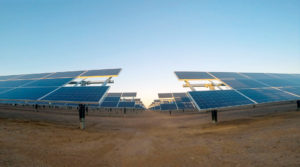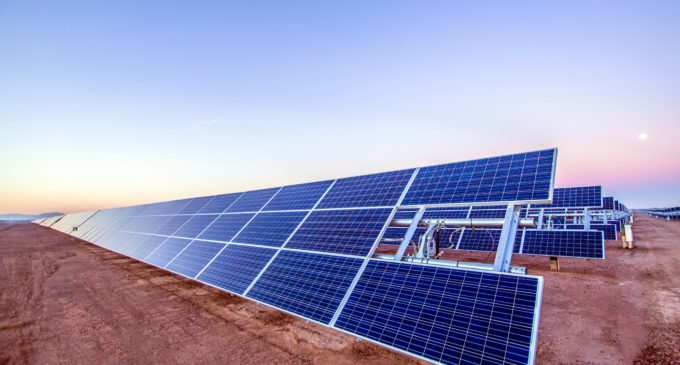Miners are discovering that renewable energy generation is good for both sustainability goals and the bottom line. There is a triple bottom line to consider when adopting renewable energy in the mining sector: economical, social and environmental, Chief Technical Officer for Mining at Black & Veatch, Dennis Gibson, tells Energy and Mines.
Gibson argues the recent focus on GHG reductions is pushing many mines towards embracing renewables as a viable power option.
However, the main problem that mines run into when implementing renewables is that they are not a 24/7 answer. “The variability of wind and solar mean you may have to integrate storage into your energy mix,” explains Gibson. “At the end of the day, mining companies are looking at quality of supply, assurance of supply and the business case.”
He adds that as the financial business case for renewables is improving, the focus on climate change is encouraging mines to act quicker. “The sustainability component is becoming increasingly important. Many mining companies are publishing their GHG and energy reduction targets and implementing focused action plans. It all comes down to the bottom line and the licence to operate,” Gibson states.
A quiet revolution in mining is leading to a much greater emphasis on sustainability. See how B&V is helping https://t.co/mTdU0vPyqD #mine16 pic.twitter.com/xby9Xixnlm
— Black & Veatch (@Black_Veatch) October 4, 2016
Shareholders are also beginning to look at mining companies’ sustainability as a “key deliverable, moving from a ‘nice to have’ to a ‘need to have’.”
Renewables — realistic option for mines
In the meantime, technological progress is making renewables more attractive for mines. Some of the major advances include the lower cost of solar PV. “It used to be very expensive and has been driven down remarkably over the last number of years. Now, it is at grid parity or even below in certain areas — making renewables more viable,” Gibson notes.
There are also impressive improvements in terms of wind turbine technologies, when it comes to the design of these systems. In addition, storage options, which have always been a challenge, are improving. “Opportunities to integrate storage with a particular renewable option, make renewable energy a more feasible alternative,” he adds.
However, aside from the impressive technological progress, a lot depends on the location of the mine site and “what really works for each particular mine.”
One cannot just assume that renewables will work everywhere, Gibson argues. The technology has to be applicable to the mine’s energy challenges. For instance, many mines in developing countries across Africa are experiencing load shedding and renewables can play a role in delivering security of supply at a known cost .
“We look at whether there is a good solar potential, good wind potential, geothermal opportunity, or hydro and then decide on the best energy mix” says Gibson.
Renewable solutions for mines should be determined by taking “an overall program view,” where all available options can be examined, Gibson adds. The key is to look at how the potential of an energy source can be maximized.
Wherever possible, the idea is to install renewables, such as solar panels, on the real estate that has already been impacted, thereby reducing any additional environmental impact.
“For example, we would look to install on former mine lands, or operating sites, we would look at disturbed areas such as waste dumps [as a potential location for renewables],” Gibson clarifies. “That is something we’ve looked at for particular projects in Africa and South America.”

Black & Veatch works with mining clients on sustainability solutions and seeks to assist clients in driving down operating costs or opex. “Energy is a significant component of opex,” Gibson explains. “Energy prices continue to rise and there are certain operations where power costs can be up to 50% of operating expenses, or even more in certain areas.”
With commodity prices down, miners are focusing significantly on how to reduce those costs. “Renewable energy could replace the operation of diesel generators to provide a more sustainable solution at lower cost depending on where they are located,” Gibson highlights.
Sharing infrastructure for renewables
Mining companies are also starting to consider sharing renewable energy infrastructure to lower overall costs of installation as well as to create a reliable supply of solar or wind power, Gibson states.
“Miners are now looking at the potential for shared infrastructure, where they can split the cost and potentially take that off the balance sheet. So the financials look a lot more positive. In Chile, for example, there are a number of mining companies who can potentially get together and have a large scale renewable source of supply as a key part of their energy mix,” Gibson says.
One potential barrier to broader adoption are lower commodity prices, which pose a threat to alternative energy projects. Lower prices have put pressure on mining companies in terms of technical project prioritization and rationalization, which can affect renewables.
“The less capital that is available the more focused mining companies are going to be on where they spend that capital. Once capital is rationalized, that can impact the financial business case for the use of renewables,” Gibson points out.
Alternative power becoming more acceptable
Nevertheless, the future of renewables in the mining market is looking very bright, says Gibson.
“Mining companies are not generally keen to change from proven technologies. But, as more and more miners embark on the renewable energy path, for example Rio Tinto’s wind energy at the Diavik Diamond Mine, it becomes more accepted as an option.”
Gibson describes an uptick in its mining clientele that is interested in pursuing renewables. “There are a number of mining companies that are looking at the importance of the sustainability components of renewable energy, environmental benefits and social acceptance, especially as technology improves and cost reduces.”
Moreover, the conversation around climate change has largely been “accepted by mining companies as something they need to zero in on,” which means that renewable energy could be a “real focus for the future.”

